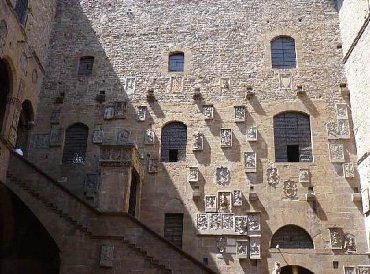From the Bargello to the gallows

Nowadays the Museum of the Bargello in Florence treasures precious and important Renaissance statues but originally it was a prison and seat of the police authority. Here convicts were imprisoned, sometimes tortured, and from here started their final journey.
In XV century Florence the already caught convict was carried in the dungeons of the palace and interrogated by torture. Among the most commonly used torture there was the so called "traits of the rope." The sentenced was tied by the wrists behind the back with a very long rope and then by means of a wheelbarrow attached to the ceiling he was pulled upward so that the body weighted all on the shoulder joints.To increase the pain these moviments were performed in spurts, inevitably causing the dislocation of the arms. A person subjected to this torture, if survived the torture, remained an invalid for life.
The condemned to death, before traveling to the place of execution, spent the night in the Chapel of St. Mary Magdalene where they could prepare spiritually and confess their sins. Then, the morning he was taken up on a kind of wagon with the Executioner, his assistants and members of the Black Society (Compagnia dei Neri) who, dressed in a hooded black canvas, accompanied the convicted comforting them spiritually.
From the Bargello the condemned therefore departed for his last journey to the "Prato della Giustizia"(Fields of Justice), a quite eloquent name, passing through a street with an equally evocative name "Via de 'Malcontenti', (discontents) which still exists today and runs alongside the church of Santa Croce leading to the Tower of the Zecca Vecchia. On the way there were, and still are, a number of shrines, specially buit to allow the condemned who passed to prepare adequately for the execution.
The path that those sentenced to death walked through to reach the place of the execution remained the same for several centuries. Then, in 1531 it changed because the place of execution was moved to the lawn outside the Porta Santa Croce, now in Piazza Beccaria.The path of the condemned started then to follow a different route.
In XIX century the prison was transferred to the Murate, and the Bargello complex underwent restoration. In 1865 it was inaugurated as National Museum, thus transforming the building from a place of suffering into a place collecting priceless works of art.











